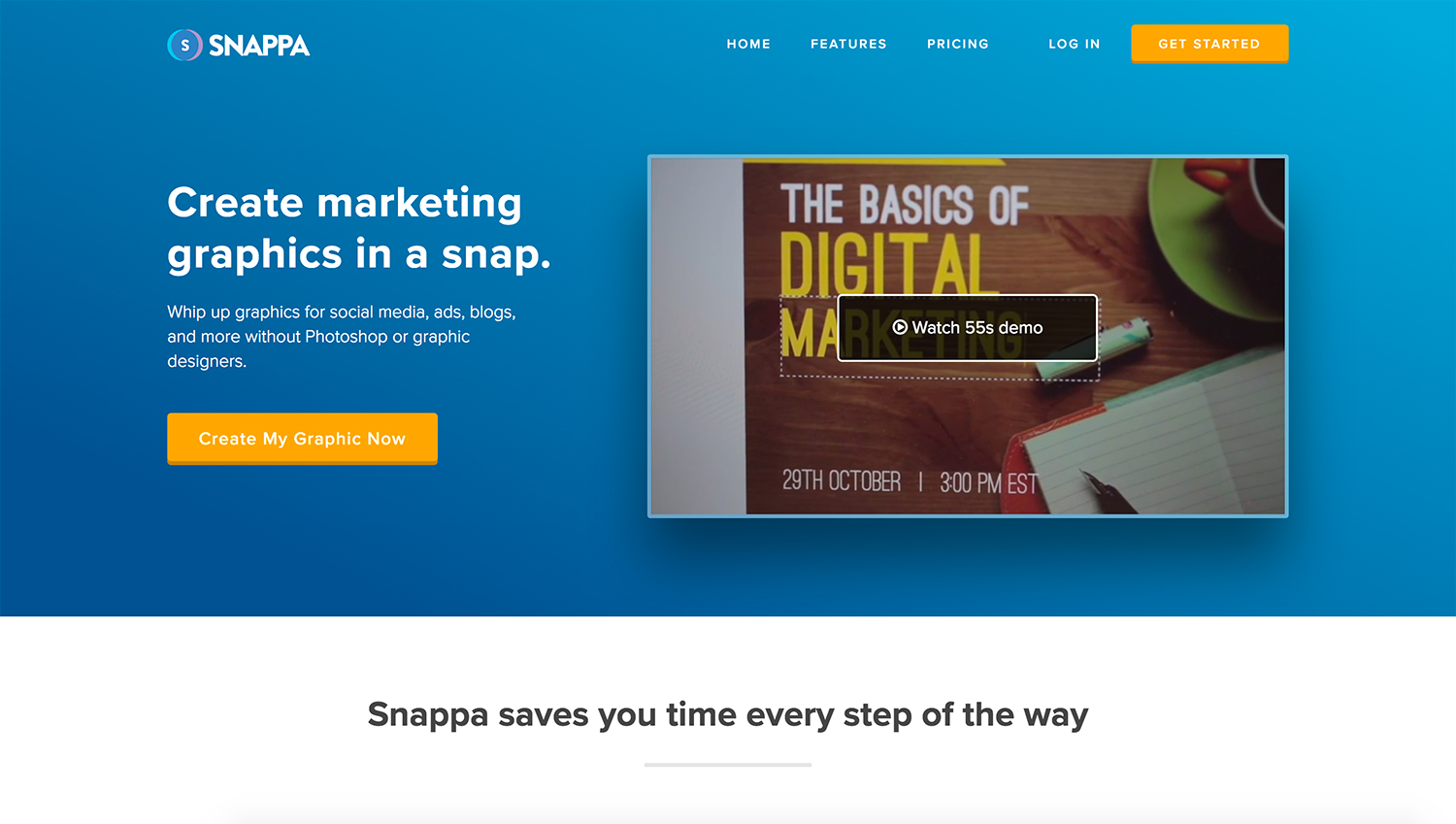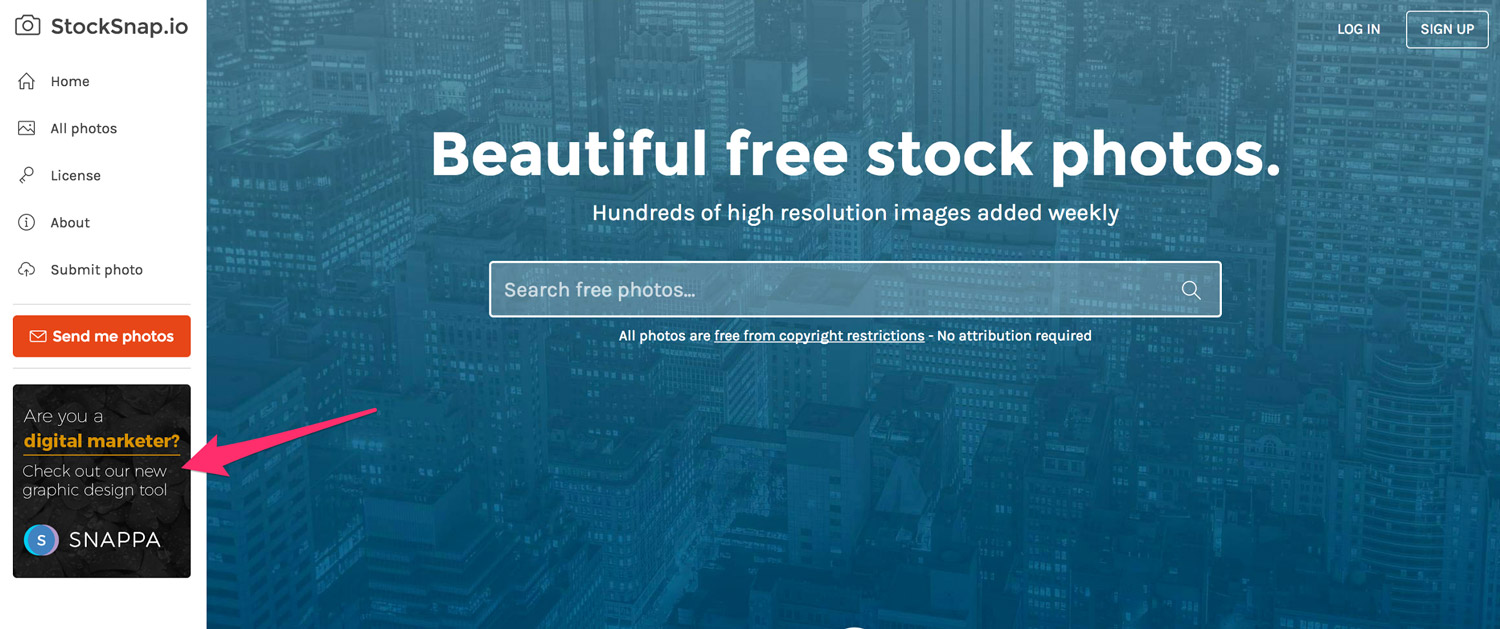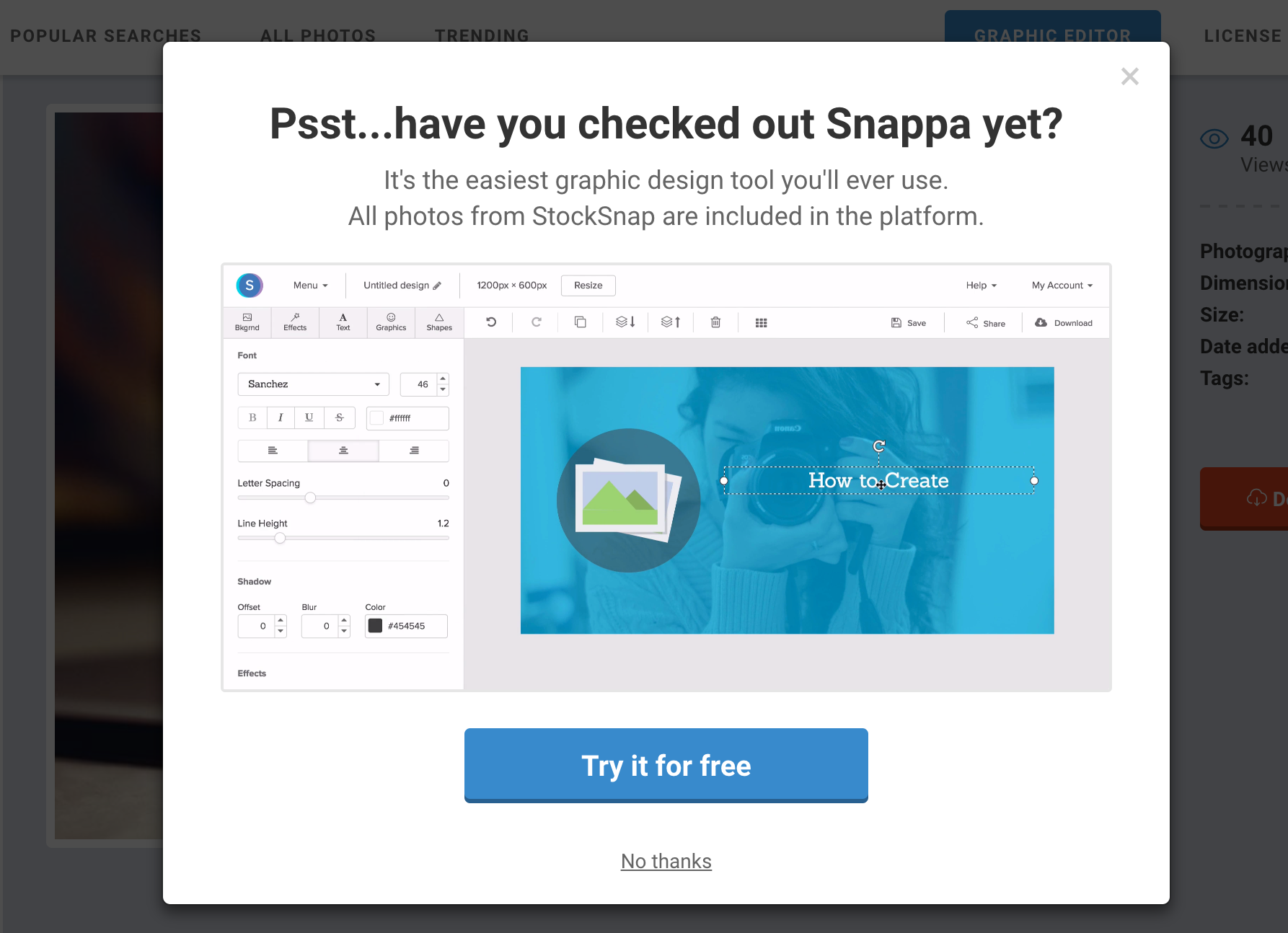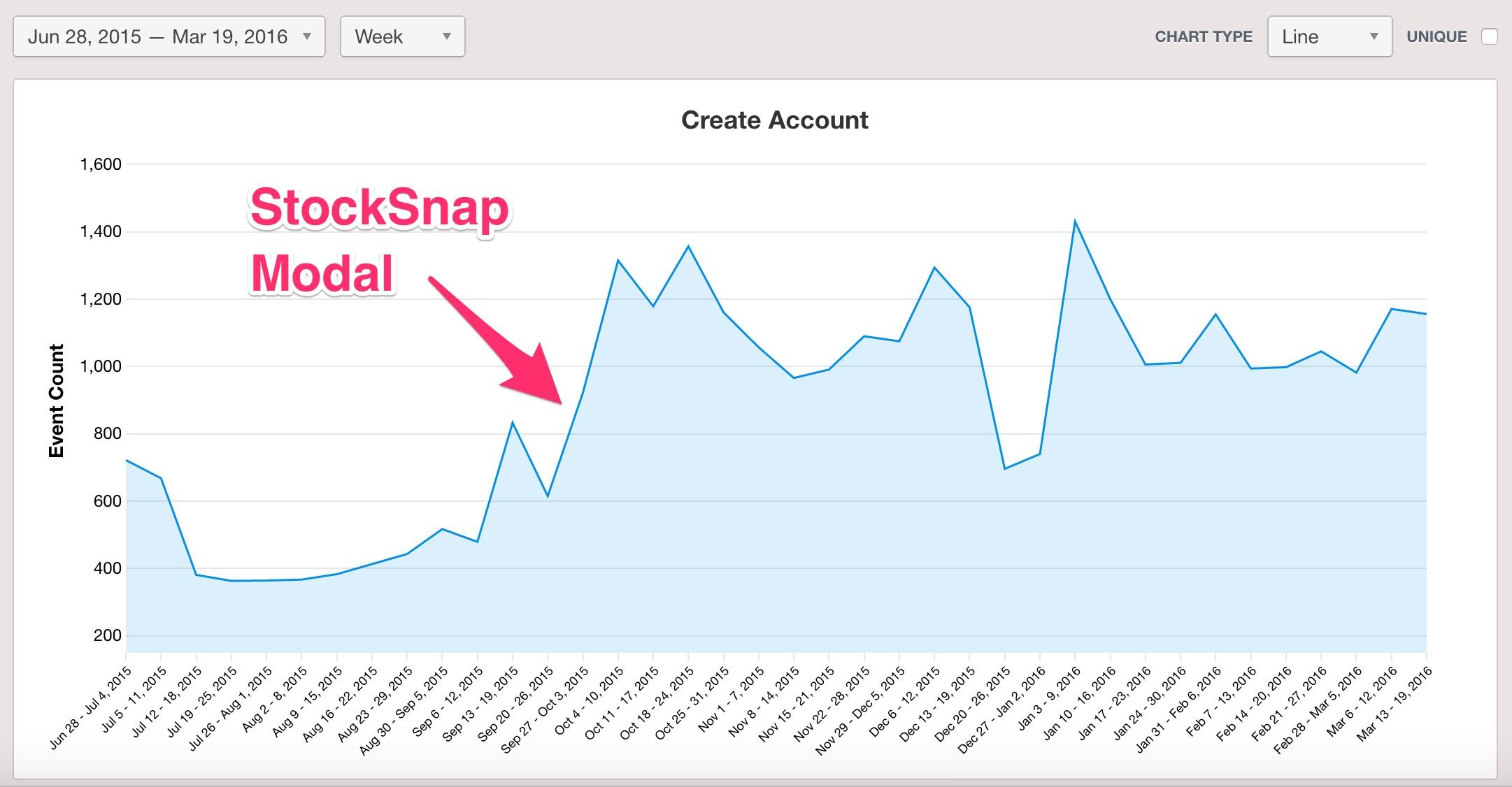Using Low-Cost Marketing Strategies to Generate $26k/mo
Hello! What's your background, and what are you working on?
Hey there! My name is Christopher Gimmer, and I'm the co-founder of Snappa, a SaaS app that helps non-designers create online graphics.
Before diving into entrepreneurship, I actually worked as a financial analyst for the Canadian government. After doing that for 5 years, I eventually got really tired of the corporate life and started getting really interested in building an online business. After working on quite a few different projects (some successful and some not), it eventually lead me to Snappa.
Snappa makes it incredibly easy to whip up graphics for social media, ads, blogs, and more without relying on Photoshop or graphic designers. Snappa saves you time every step of the way with preset image dimensions, pre-designed templates, and a huge built-in library of photos, graphics and fonts.
Since launching in November 2015, more than 1 million images have been created using our software, and we just crossed $26,000 in MRR.
What motivated you to get started with Snappa?
Before we launched Snappa, my co-founder Marc and I were working on a business called BootstrapBay, a marketplace for premium Bootstrap themes and templates. While growing the business, we found that content marketing and SEO worked very well.
Since it was just the two of us, I was responsible for writing and publishing all of the content on our blog. However, I was the furthest thing from a designer. Every time I needed to create images for the blog, it was a constant struggle. Even though I knew the basics of Photoshop, it took way too long to create images, and they simply didn't look good.
When I looked around to see what was out there, I found that other graphic design tools fell into two categories. They either had tons of features but were difficult to use, or they were easy to use but had limited functionality. With the growing importance of content marketing and social media, I figured there needed to be a graphic design tool that was both easy to use, but offered enough functionality to create highly engaging images.
Essentially, I wished there was a graphic design tool for marketers and entrepreneurs like myself.

Did you do anything to validate the idea?
Around this time, I had written a blog post on where to get free stock photos that went viral. Shortly after, we decided to create our own free stock photo site, StockSnap.io, because of how popular the CC0 movement was becoming. (CC0 is a "no copyright reserved" option that effectively means relinquishing all copyright and similar rights that you hold in a work and dedicating those rights to the public domain.)
After launching StockSnap on Product Hunt and linking to it in our blog post, it started to take off. Next thing you know, we had a stock photo site that was generating over 1M pageviews a month. We knew that some percentage of these users would probably be interested in a tool like Snappa.
Over the next month or so, I set out to validate the idea of a graphic design tool that was geared towards marketers and entrepreneurs. I started by sending out a survey to people who opted in for our StockSnap newsletter. The survey simply asked what people were using the stock photos on our site for. An overwhelming amount of them said blogging and social media, which was exactly the audience we were hoping to serve with Snappa.
After the survey results, I followed up with some of the respondents and conducted about 10-15 Skype interviews. I wanted to know what their current process was for creating graphics and what their pain points were. It turned out that many of the people I interviewed were going through the exact same struggles that I was. For me, that was enough validation to build an initial prototype.
At that point, we decided to put BootstrapBay on autopilot and started putting all of our energy into Snappa. Marc started developing the initial prototype while I worked on building up a launch list.
What went into building that initial prototype?
The first business we ever started was a student dating website called ClassmateCatch. It took about 4 months to build (nights and weekends) and the business eventually failed. Determined not to make that mistake again, we set out to build the most basic version of Snappa that we could.
At this point in time, Marc was still working a day job, so he didn't have a ton of time to work on the product. We also didn't have any money to hire other developers. Using PHP with FabricJS as our editor library on the client side, Marc started writing the first few lines of code towards the end of March 2015.
Three months later, we released our initial open beta on July 1, 2015. It was very basic. It had no templates, you couldn't search for built-in graphics, and you couldn't even save your designs. But despite the lack of features, people responded well to the product.
We tracked usage of the product through Heap Analytics and we saw that the number of images being created kept going up each and every week. We also noticed that a number of users were coming back consistently to create new graphics. This gave us the confidence to push for an initial release and start charging for the product.
The great thing about releasing our beta early was the feedback we got from users. Some of the features we didn't think were that important turned out to be very important (and vice versa). Had we kept working on the product ourselves without releasing a beta, we probably would have wasted a lot of time building the wrong things.
We kept track of all incoming feedback using Trello (which we still do to this day). As the feedback came piling in, we tried to determine what was absolutely crucial for launching and what wasn't. We knew that the longer we waited to charge, the longer we were waiting to truly validate the product.
After we launched the beta, Marc had also taken a leave of absence from his day job, so the both of us were living off the BootstrapBay profits that were starting to decline since we put it on autopilot. Considering we were bootstrapping Snappa, we needed to generate revenue ASAP.
We wrote down the few critical features that we felt were absolutely necessary and swore to ourselves that we wouldn't build any other features that weren't on this list until we were generating revenue. Staying true to our word, we built out these features and officially launched Snappa on November 22, 2015 with a freemium model.
How have you attracted users and grown Snappa?
Cross Promotion
In the early days, StockSnap was absolutely critical to the success of Snappa. Not only were we able to validate our idea with this audience, we also built our launch list almost entirely from this userbase. To do so, we added a banner ad for Snappa in the sidebar of StockSnap.

When users clicked on that banner, it took them to a landing page where they could sign up for the Snappa beta. Over the three month period that we were building Snappa, we grew our launch list to 2,754 email subscribers.
After the beta was launched, we continued to use StockSnap to cross-promote Snappa. Seeing how well it worked to build our initial launch list, we started to optimize the number of signups we could generate from it. After running a few different tests, we were able to nearly triple our signups by adding a modal with an animated gif of Snappa in action after someone downloaded their first image on StockSnap.

After implementing the modal, we went from averaging 400 signups per week to over 1,000:

SEO and Content Marketing
Once we optimized the number of signups we could generate from StockSnap without becoming too pushy, we tested a variety of other marketing channels. The low price point of Snappa made paid advertising virtually impossible. It also made it difficult to pursue any marketing efforts that required a large amount of resources.
As a result, we decided to focus on content marketing and SEO which was a scalable "free" way to generate traffic. I also had expertise in this area from our previous business.
After experimenting with various types of content, we found that long-form evergreen content worked best. We moved to a bi-weekly publishing schedule and only wrote content that had potential for bringing in a decent amount of organic traffic. We used tools like the Google Keyword Planner, AHFREFs Keyword Explorer, and KeywordTool.io to find relevant keywords.
We also prioritized content that was middle to bottom of the funnel. For example, we noticed that "Twitter Header Size" was getting searched 30,000+ times per month and this topic was highly aligned with our target audience. So, we wrote a post about the perfect Twitter header size and added a call to action directly within the post. This single post drives 500+ signups per month for Snappa and we've since been working on more content like this.
Product Hunt
We also wanted to launch on Product Hunt like most software products. However, since we were already getting solid traction at our launch, we decided to wait until the product was more mature to really maximize the benefit.
We finally launched on Product Hunt in June of 2015, seven months after we actually released the product. We finished as the #1 product of the day with over 1,000 upvotes. We were also featured as one of the most-loved products launched in summer 2016. Waiting to post on PH was definitely the right strategy.
Partnerships
Another thing that worked really well for us was partnerships with non-competing companies in our space.
Shortly after we launched, one of our customers introduced me to the head of business development at LeadPages. We then ran a hugely successful promotion where they purchased annual licenses for our product at a deep discount then offered them as a free incentive for LeadPages customers who upgraded to an annual plan. This lead to our biggest week of sales and generated a lot of exposure.
After seeing the success of this campaign, we reached out to other SaaS companies and ran similar promotions with Sumo and Gleam.
Word of Mouth
Naturally, word of mouth started to spread as we started driving more and more signups to our product.
Taking a page out of Alex Turnbull's playbook, I had an automated email in the earlier days that asked people why they signed up for Snappa. A surprising amount of people said they signed up because of a friend or colleague's recommendation.
Furthermore, we started getting written up in a lot of marketing blogs and getting shared by influencers. I think the freemium nature of our product has definitely helped with word of mouth and referrals.
Since launching, it's been a steady climb to 2,000+ paying customers.
| Month | Revenue |
| Nov | 238 |
| Dec | 389 |
| Jan | 495 |
| Feb | 561 |
| Mar | 722 |
| Apr | 884 |
| May | 946 |
| Jun | 1105 |
| Jul | 1196 |
| Aug | 1341 |
| Sep | 1492 |
| Oct | 1592 |
| Nov | 1674 |
| Dec | 1706 |
| Jan | 1845 |
| Feb | 2005 |
| Mar | 2139 |
How does your business model work?
Snappa's business model is extremely simple. We offer a free Starter plan and a paid Pro plan. Our Pro plan costs $10/month when paid annually or $15 month-to-month. Since all of the photos and graphics included in our library are royalty-free, there are no additional fees whatsoever.
We learned early on from customer interviews that people really don't like one-time fees. Other products in our space sometimes charge one-time fees for templates or photos and only allow you to use them within in a 24 hour window.
As a result, we wanted to make our pricing as frictionless as possible. If customers need a photo that they can only find from a paid stock library, they can easily upload it into our platform.
What does your revenue growth look like?
Since we only have one paid plan right now (a team plan is on the way), our revenue growth has mirrored our customer growth. It's been a steady climb to $26k MRR since launching.
| Month | Revenue |
| Nov | 2095 |
| Dec | 4093 |
| Jan | 5625 |
| Feb | 6483 |
| Mar | 8768 |
| Apr | 10925 |
| May | 11691 |
| Jun | 13661 |
| Jul | 14806 |
| Aug | 16566 |
| Sep | 18450 |
| Oct | 19745 |
| Nov | 20320 |
| Dec | 20765 |
| Jan | 22490 |
| Feb | 24435 |
| Mar | 26240 |
What are your goals for Snappa's future?
The more I talk with customers, the more I realize we're solving a real problem and creating a lot of value for our target market. Our goal is to make Snappa the #1 graphic design tool for marketers, entrepreneurs, and small businesses.
From a product perspective, we're working on a team plan which will enable multiple people from the same team/business to share and collaborate on graphics together. At the moment, teams are forced to share a login or purchase multiple subscriptions that aren't connected. Once we launch our team plan, we'll be in a much better position to carry out our mission.
From a revenue standpoint, our goal is to hit $1M in annual recurring revenue. We don't plan on raising any investment at this point.
What are the biggest challenges you've faced?
Some of the biggest challenges we've faced have been on the technical side. The first version of our graphic editor was built using the FabricJS library. Although it enabled us to launch quickly, we ran into limitations early on.
For example, the biggest feature request we kept getting after launching was image resize. Our users wanted to create a Facebook graphic then automatically convert it to Twitter's size (we've since added this feature). Doing this using FabricJS would have been a nightmare.
Furthermore, as we looked at all the other feature requests and where we wanted to take our product, we knew that continuing to build on Fabric would pile on a huge amount of technical debt. So we made the difficult decision to completely rebuild the editor portion of the app just a few weeks after launching. The new editor served us really well for the next little while. However, we reached another roadblock when scaling, performance, and more advanced feature requests started becoming an issue.
At that point, the app was built on PHP with a dedicated host. As we searched for a better solution, we realized that NodeJS would give us access to a variety of useful packages and would also allow us to host our app on Amazon EC2 for easy scalability. Once again, we underwent a major re-write and completely overhauled the back-end of our app. We're now at a place where we're very satisfied with our codebase and the scalability of our app.
It's easy to look back and say "we should have done this differently," but hindsight is 20/20. Our priority in the beginning was simply to launch, and we did it using the technology we were comfortable with at the time. Having said that, we definitely made the right decisions to rewrite certain portions of the app when we did. I would caution other founders to learn from this and plan ahead whenever possible.
Outside of the technology, the other main challenge has been growing a product with such a low price point. To support an app where you're only charging $10-15/month, you need a lot of customers.
Fortunately, the audience we built beforehand and our marketing efforts have paid off but it's going to be challenging to grow to a $1M ARR business unless we can increase our average price per customer and lower churn. We're hoping that successfully launching the team plan will help in this area.
What were your biggest advantages? Was anything particularly helpful?
Like I mentioned previously, our biggest advantage by far was the audience we had built with StockSnap beforehand. This allowed to us validate our product and became the initial marketing channel that spurred our growth. Other successful founders, like Nathan Barry, have used the exact same playbook.
Another thing we did well was relentlessly prioritize our development, which is critical for a bootstrapped startup. Rather than work on small incremental improvements that would only take a couple days to code, we focused on the big features that would help us get more customers or reduce the amount of cancelations. We realized that one game-changing feature was more valuable than ten nice-to-haves that people could live without.
Finally, I'm a strong believer in momentum and a mantra that I've developed is "daily progress." Every day I make sure to accomplish at least one thing that will help me move the needle in our business. This could be writing a blog post, talking to customers, or connecting with an influencer.
By focusing on small incremental wins day in and day out, you'll be shocked just how much they'll snowball over the next 6-12 months and beyond. That is, if you're working on the right things.
What's your advice for indie hackers who are just starting out?
First, I would tell them to read the book Traction. This is one of the very few business books that will actually help you get your startup off the ground. It's one of the only books that I recommend regularly.
Second, start anything. We jumped from a student dating website, to a guest list system for nightclubs, to a marketplace for Bootstrap templates, to a SaaS app for creating graphics. Each step along the way I learned several things that I took with me into the next project. Each project became more successful than the last.
It's extremely rare for your first startup to takeoff, so don't waste several years trying to come up with the perfect idea, because it will probably fail anyways. Instead, you need to get yourself "in the game." The more you hustle and experiment with stuff, the more you'll learn, the more people you'll meet, and the more lucky you'll get. At some point, you're likely stumble on the thing you were meant to work on and momentum begins to kick in.
Where can we go to learn more?
First, you can check out Snappa.com if you'd like to learn more about our startup.
Second, you check out my personal blog at ChrisGimmer.com. I haven't posted much, but I've written a few detailed case studies that may be helpful. I've also posted some of my favorite podcast interviews that I've done.
Finally, you can hit me up on Twitter. My handle is @cgimmer.
If you have any questions about anything mentioned in this write-up, leave a comment below and I'll be happy to answer it.
Thanks for having me :)

Hi Chris, would you mind sharing your current monthly revenue?
Hi Chris. Great achievement and truly inspiring. Can you please share if you are using any tool to track user feedback in and then recording it in trello? The reason i asked because we have recently launched a product (https://www.feedbackrig.com/visual-feedback.html) that captures customer feedback via in-app widgets and converts it into trello cards (along with technical details such as browser info, OS, screen resolution etc) User may also highlight the areas that need your attention. Looking forward for your feedback. Thanks.
Hi Christopher,
I've really enjoyed reading this interview, it was inspiring and I've learned a lot from it.
I would like to know more about how did you attract users to StockSnap. In your interview you said that it generating over 1M pageviews a month. Could you explain how did you manage to achieve it?
Good luck!
Omri
Two things...
We posted on Product Hunt which did very well. https://www.producthunt.com/posts/stocksnap
We already had a blog post that was ranking for "Free Stock Photos" so we simply added StockSnap to the list.
Those two things gave us lots of visibility in the beginning and we started to get mentioned in a lot of articles. Eventually we were ranking for terms like "free stock photos" and "free stock images" and were getting consistent traffic from Google.
What's the differentiation with Canva? I 've been using it for a while.
How does Snappa compete with service like https://html5maker.com ?
I've never heard of this service before and I'm sure there are tons of other competitors that exist. We focus on 3 main areas:
Hi Chris,
Great achievement. I've been a fan of Snappa ever since I found it on ProductHunt. What caught my attention the most from this interview is the "cross-promotion" part. If you want to take this strategy one step further, you might want to give https://cross.promo a try. It's the first cross-promotion platform for SaaS and online businesses. It's newsletter based, so it's more personal and the conversion rate is even greater. If this is of interest for you, feel free to email me at [email protected]
All the best and thanks again for sharing your success story.
Felix
Great interview, really enjoyed how you talked about building momentum and taking successes with you into each project. I'm working on a sales agency selling booth space for small trade shows/conferences. I have a landing page, blog, already talking w/ a few customers..I'm not sure where it will take me but I'm learning so much and love the industry so why not!
Christopher, excellent interview. What do you currently use for image processing?
I am curious as I just wrote my own image resizing service for me side project.
Glad you liked it. We use Imgix for processing images.
Hi Christopher, thanks for sharing! Any resources you would recommend for learning SEO or internet marketing?
I'd start by reading Moz' Beginner's Guide to SEO:
https://moz.com/beginners-guide-to-seo
After that, I'd read all the content on Backlinko.com. That would be a good start.
Learning internet marketing is not something you can learn overnight. I'd recommend keeping up with sites like GrowthHackers.com and following some of the reputable people in the space .
Of course, learning by doing is always the best way to go. Start a side project and start experimenting.
This comment was deleted 7 years ago